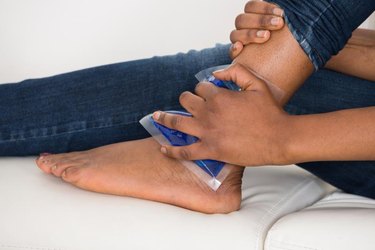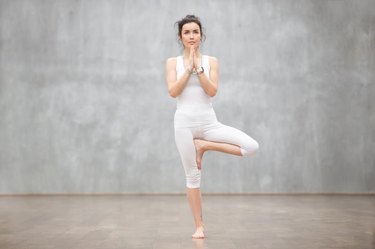
Yoga with any injury, especially to your foundation — the feet — can be tricky. However, you don't have to give up on rolling out your mat entirely. You might feel like you're alone in your injury, but the American Orthopaedic Foot and Ankle Society reports that 25,000 people sprain their ankle every day.
You need time for your ankle to heal. In the first stages of recovery, choose mostly seated and reclined poses while your ankle's swelling goes down and the ligaments heal. Following the acute injury, be sure to keep weight off the affected leg and see a doctor. He might give you a brace to wear to stabilize the region if the sprain is severe enough.
Video of the Day
Video of the Day
Read More: Degrees of Ankle Sprains
In later phases of recovery, you can include movements in your practice that help restore flexibility and range of motion. Eventually, you'll bring back the ankle's full strength and be back full-form in your practice. Of course, any yoga you do should be cleared by your doctor and remember to not rush the healing process — being too eager to do moves such as Warrior III, Dancer and jump throughs only sets back your healing.
Phase 1 of Recovery
In the immediate aftermath of the sprain, your primary strategy is RICE: rest, ice, compression and elevation. You'll be keeping weight off the ankle, so yoga poses in a chair or while lying in bed are safest. Gentle inversions will help alleviate swelling and fulfill the "elevate" portion of the healing prescription.

Chair Poses
From a standard seated position in a chair, you might perform:
Eagle arms: Wrap your right elbow under your left and then cross the forearms and wrists. Repeat with your left arm under.
Cowface arms: Lift your right arm straight up to the ceiling, and then bend it behind your back so that the elbow points up. Bring your left arm behind your mid-back and use your left hand to catch your right hand. Repeat with the left arm on top.

Seated Twist: Rotate your torso to the right, your left hand using your thigh or the chair seat to pull you deeper into the twist. Repeat to the left.
Seated Forward Fold: Lengthen your legs forward and fold over from your hips.
Reclined Poses
Lying down in bed allows you to perform:
Supine Twist: Gently draw your knees into your chest and allow them to fall to one side. Stretch your arms out to make a "T" shape and turn your head away from your knees. Switch directions.
Hamstring stretch: Reach one leg straight up to the ceiling and interlock your hands behind your thigh. Gently pull on the thigh to feel a mild stretch. Repeat with the other leg.
Shoulder Stand: Lie on your back and support your low spine with your hands. Lift your hips up off the floor, so you're balanced on your shoulders.
Legs up the Wall: Lie on your back and support your legs on a wall so that you form a 90-degree angle at your hips. If your bed isn't near a wall, alternatively just allow your legs to reach up to the ceiling, unsupported, for multiple breaths.
Corpse pose: Lie on your back and allow your arms and legs to relax. Focus on your breathing for 5 minutes or longer.
Phase 2 Recovery
Mild sprains may move into phase 2 recovery pretty soon, sometimes within 3 to 5 days after the injury. Severe sprains may take two weeks to get to a more active healing phase — you and your doctor will make the decision together.
In this second phase of healing, include some stretching exercises specifically for the ankle when you perform gentle yoga poses. As your ankle is still healing, avoid putting full weight on it or risk putting full weight on it by getting into tough balancing poses that mean you might crash down — this includes Handstand and Crow.
When you lie on your back to do a hamstring stretch, for example, point and flex the ankle joint as the leg is in the air. Rotations of the joint and inversion and eversion are also appropriate. When well into phase 2 recovery and most of the pain of the sprain has subsided, you might even hold Chair pose for a few breaths to stretch the ankle.
Phase 3 Recovery
You're returning to function in phase 3 of recovery from a sprain. Balancing and experimenting with putting full weight on the ankle are important components of this phase. Yoga can be valuable, but don't push it — you don't want to set yourself back.
You may return to all but the most dynamic of poses in yoga at this phase. Jumping and quick shifts of position, such as in an Ashtanga practice, should only be resumed when healing is complete. Stick to a gentle-paced practice, and if your feel pain, skip a pose.
Another good way to incorporate yoga and ankle healing is to perform a few select balancing poses with your affected foot on a pillow. The American Orthopaedic Foot and Ankle Society notes that this is a way to improve stability in the joint.

Try Tree pose, where you stand on the pillow with your affected foot and bring the other foot's sole to the inside of your standing leg. A One-legged Mountain pose would also be helpful. Stand on the pillow with your affected leg and then raise the other leg up so that the thigh is parallel to the floor and your knee and ankle joints are bent at a 90-degree angle.
Don't use yoga as a substitute for any other physical therapy exercises prescribed by your doctor.
- American Orthopaedic Foot and Ankle Society: How to Care for a Sprained Ankle
- Yoga Journal: I Sprained My Ankle. What Poses Can I Do?
- Journal of Athletic Training: National Athletic Trainers’ Association Position Statement: Conservative Management and Prevention of Ankle Sprains in Athletes
- American Orthopaedic Foot and Ankle Society:How to Stretch Your Ankle After A Sprain
- American Orthopaedic Foot and Ankle Society:How to Strengthen Your Ankle After a Sprain
Is this an emergency? If you are experiencing serious medical symptoms, please see the National Library of Medicine’s list of signs you need emergency medical attention or call 911.